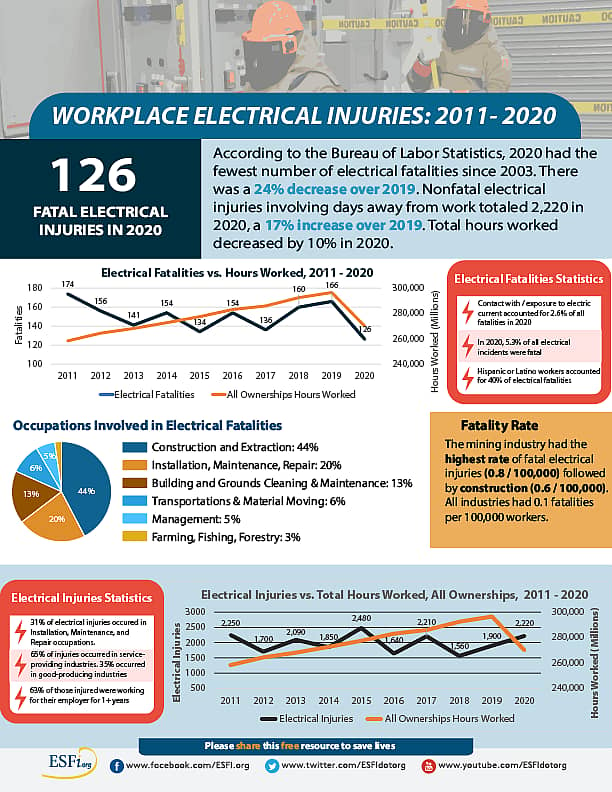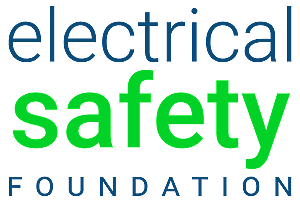
Each year ESFI collects and publishes workplace electrical fatalities and injuries data covering incidents from the previous year.
Each year, the Electrical Safety Foundation International (ESFI) collects information on fatal and nonfatal occupational electrical injuries using the U.S. Bureau of Labor Statistics (BLS) Census of Fatal Occupational Injuries (CFOI) and Survey of Occupational Injuries (SOII). ESFI then publishes the information in tabular and graphical form to esfi.org. The most recent data covers electrical injuries from 1992-2020 and fatalities from 2003-2020 but mainly focuses on 2011-2020 data.
There were 126 electrical fatalities in 2020, a 24% decrease over 2019 and the lowest number of electrical fatalities since ESFI began compiling data in 2003. It is also important to note there was a 10% drop in total hours worked in the United States in 2020, most likely due to the COVID-19 pandemic. There were 2,220 electrical nonfatal injuries involving days away from work, a 17% increase over 2019 and a return to 2017 levels. The data highpoints are as follows:
Fatal Electrical Injuries
• In 2020, 5.3% of all electrical incidents were fatal.
• Contact with / exposure to electric current accounted for 2.6% of all fatalities in 2020. This is a 19% drop from 2019 and a return to 2017 levels.
• Electrical fatality rates were 0.09 fatalities per 100,000 workers (22% drop from 2019). The rate for all fatalities was 3.5 per 100,000 workers in 2020, slightly above the 2019 rate.
• The mining industry had the highest rate of fatal electrical injuries (0.8 / 100,000), followed by the construction industry (0.6 / 100,000) in 2020. All industries had 0.1 fatalities per 100,000 workers.
• “Constructing, Repairing, Cleaning” accounted for the leading worker activity for electrical fatalities at 64%. “Using or Operating Tools, Machinery” accounted for 22%.
Occupations involved in electrical fatalities:
• Construction and Extraction Occupations: 44%
• Installation, Maintenance, and Repair Occupations: 20%
• Building and Grounds Cleaning and Maintenance Occupations: 13%
• Transportations and Material Moving Occupations: 6%
• Management Occupations: 5%
• Farming, Fishing, and Forestry Occupations: 3%
Nonfatal Electrical Injuries
• There were 2,220 nonfatal electrical injuries involving days away from work. This was a 17% increase over 2019 and a return to the same levels as 2017.
• 0.19% of all nonfatal injuries resulting in days away from work could be attributed to electricity during 2020. In 2019, 0.21% could be attributed to electricity.
• A total of 1,176,340 workplace injuries occurred in 2020. Of these cases, 33.2% (390,020 cases) were categorized as other diseases due to viruses not elsewhere classified, which includes reported COVID-19-pandemic related illnesses.
Occupation of workers involved in a non-electrical injury:
• Installation, Maintenance, and Repair: 31%
• Service: 25%
• Construction and Extraction: 21%
• Production: 11%
• Transportations and Material Moving: 5%
• Management, Business, Financial: 2%
• Sales and Related: 1%
• Healthcare Practitioners and Technical: 1%
• Computer, Engineering and Science: 1%
• Office and Administrative Support: 1%
The industries with the leading number of nonfatal electrical injuries included:
• Construction: 20%
• Accommodation and Food Services: 22%
• Wholesale Trade: 17%
• Manufacturing: 14%
Despite a drop in electrical fatalities, electrical injuries increased by 17% in 2020. By studying how and why workers are getting hurt, ESFI can create new materials to help educate all workers, whether they work regularly with electricity or not, to stay safe on the worksite to prevent these avoidable incidents. For free-to-share materials you can spread throughout your workplace, community, or home, visit esfi.org.
ABOUT ESFI
ESFI is a 501(c)(3) non-profit organization dedicated to promoting electrical safety at home and in the workplace. For more information and to use ESFI’s free resources throughout your community, visit esfi.org.
###




